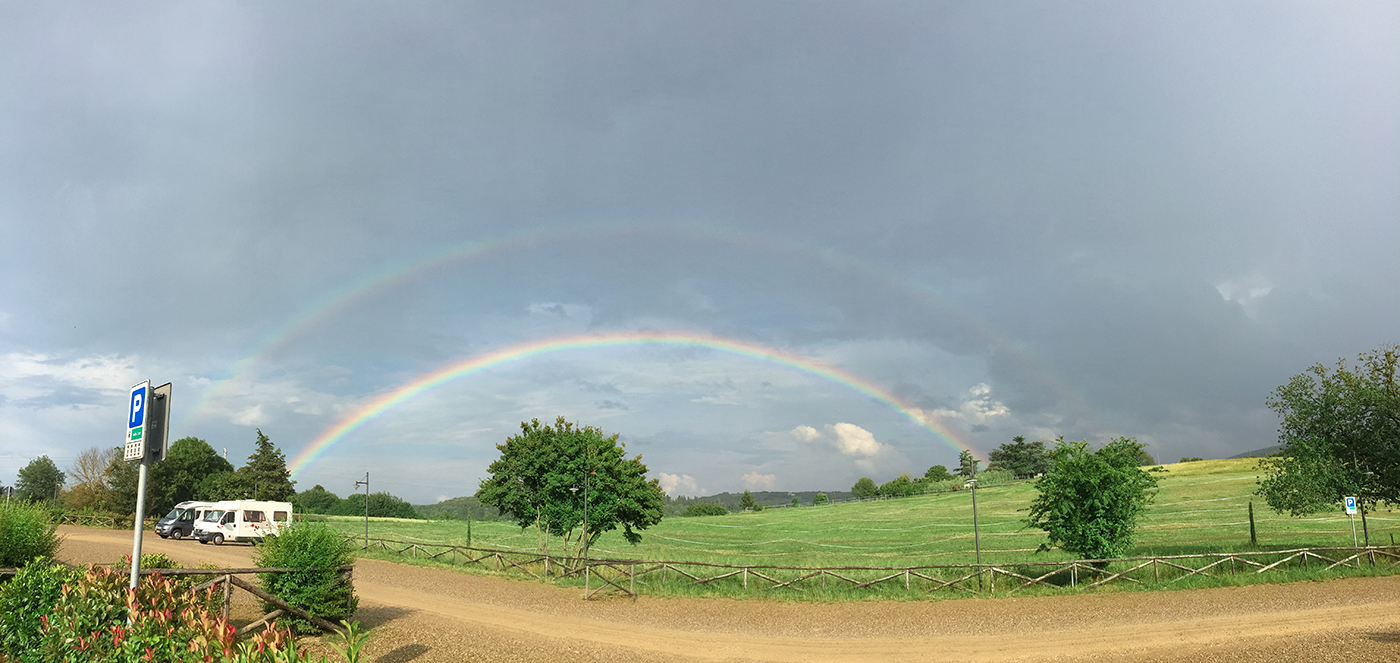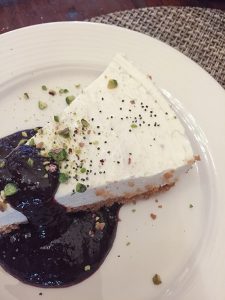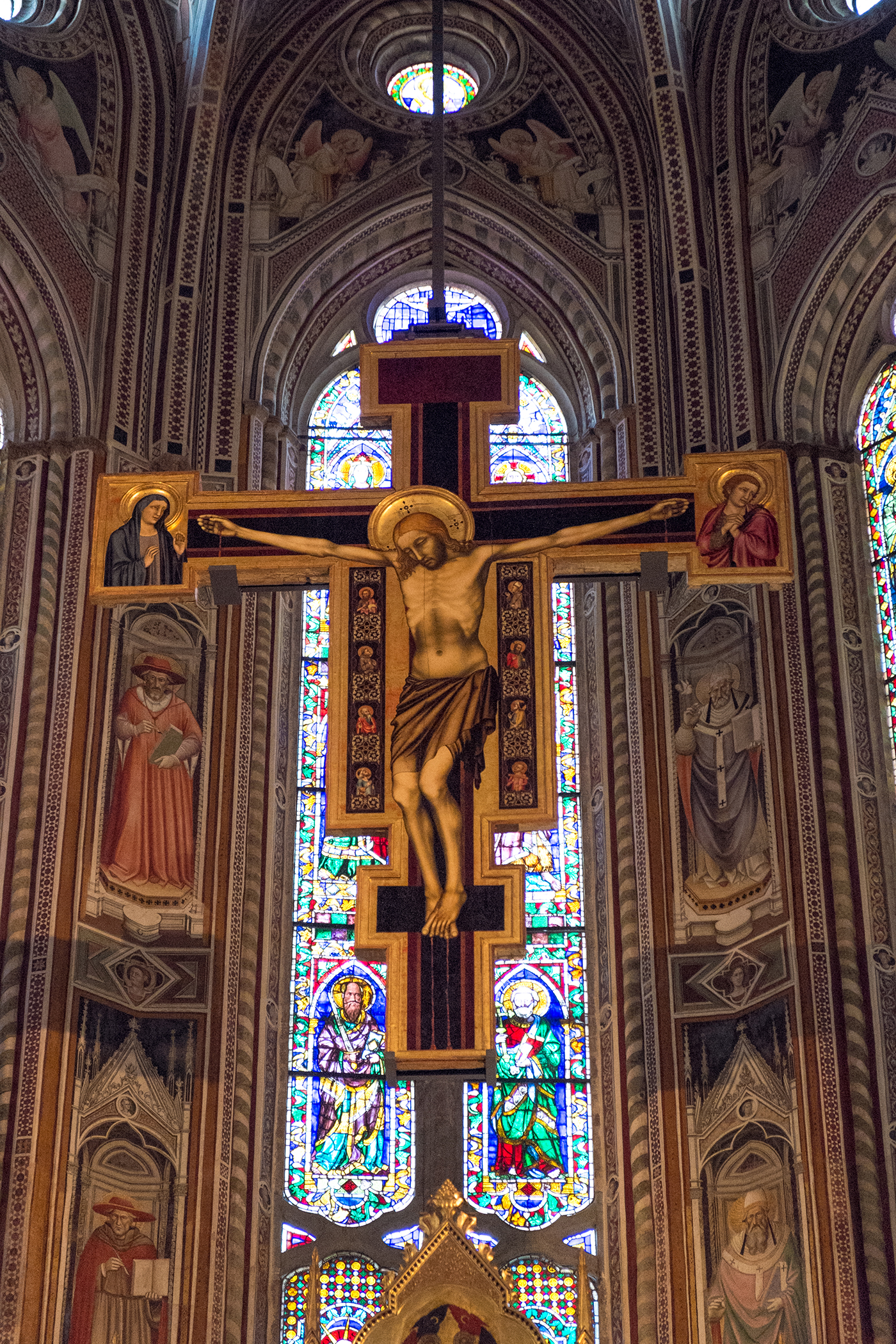After we got off the train from Venice we walked to Hotel dei Macchiaioli to drop off our bags and then headed out to explore. We visited Basilica di San Lorenzo and then walked by Firenze Barbecue Ristorante, which had some seating outside. Spaghetti Carbonara for Mom and Pizza Margherita for me.
 BASILICA DI SAN LORENZO
BASILICA DI SAN LORENZO
Basilica di San Lorenzo has a complicated building history. Even though it was built – at least partially – under the direction of Filippo Brunelleschi, it is not purely of his design. Michelangelo created a marble design for the facade but it was never implemented. The project was begun around 1419, but lack of funding slowed down the construction and forced changes to the original design. It is the burial place of all the principal members of the Medici family from Cosimo il Vecchio to Cosimo III as well as Donato di Niccolò di Betto Bardi, better known as Donatello. Near the altar are two bronze pulpits, created by Donatello, his last work. After he died in 1466 the pulpits were completed by his students. They are currently undergoing restoration but one was completed at the time we visited (mom shown standing next to it) and the detail was incredible.
The next day we went on a day tour to Pisa, a post I’ve separated and can be viewed HERE.

After Pisa we decided on a wine tour to Tuscany.

First Stop: Poggio Amorelli is located in the Chianti area, a little over a mile from the old village, Castellina in Chianti. Its 63 acres of which 25 are planted with chianti classico grapes and 10 are for production of olive oil.

 Second Stop: Monteriggioni is a medieval walled town built on a hillock by the Sienese in 1214 as a front line in their wars against Florence. The Griccioli’s family bought the village in 1720. Monteriggioni was also referenced in Dante Alighieri’s Divine Comedy.
Second Stop: Monteriggioni is a medieval walled town built on a hillock by the Sienese in 1214 as a front line in their wars against Florence. The Griccioli’s family bought the village in 1720. Monteriggioni was also referenced in Dante Alighieri’s Divine Comedy.


The Chianti wine country was amazing. A scene right out of an Italian tour book. And a double rainbow as we left – come on – how can that be beat.

 THE BLACK ROOSTER
THE BLACK ROOSTER
A proud designation which represents the strict government regulations, overseeing everything from the yield to production that uphold the reputation of Chianti Classico. Branded in 1384 as the emblem for the League of Chianti, today the label is placed on the neck of a bottle of wine from the Chianti Classico zone.
But why a Black Rooster? Legend states that red wine had been produced in this area since around 1000 A.D. and Florence and Siena long feuded over rights to this region. Finally, around 1200, they agreed to end the feud with a competition. Horsemen were to depart from the rival cities at the crow of a rooster. Wherever they met would determine the boundary lines and settle the dispute once and for all. While the Sienese chose a well-fed white rooster, the cunning Florentines chose a starving black rooster. On the day of the event the white rooster dutifully crowed at sunrise, but the poor hungry black rooster had begun to crow long before, thus giving the Florentine rider a considerable advantage. The Sienese horseman didn’t get very far and the borders were established.
 After a very long day on the bus tours we were ready for some food. A few doors down from our hotel was a spot that I had marked as highly rated, Il Desco Bistrot. Mom ordered the lasagna with sheep milk ricotta and homegrown zucchini, and because of their limited menu (and my picky palate) I decided on dessert, cheesecake with cherry jam. We shared and both were absolutely amazing.
After a very long day on the bus tours we were ready for some food. A few doors down from our hotel was a spot that I had marked as highly rated, Il Desco Bistrot. Mom ordered the lasagna with sheep milk ricotta and homegrown zucchini, and because of their limited menu (and my picky palate) I decided on dessert, cheesecake with cherry jam. We shared and both were absolutely amazing.
The next day we had our Best of Florence walking tour which included going to the Galleria dell’Accademia to see Michelangelo’s David (where it’s now located), the Duomo, the Palazzo Vecchio (where David originally stood) and the Uffizi Gallery with views of Ponte Vecchio arch bridge.
 There was a break before the Uffizi Gallery tour and so we walked down an alleyway to look for a good gelato place. We saw Carapina and decided on “chocolate-nut” it was love at first bite. Tasted like nutella and we were hooked. I thought the name sounded familiar and after looking at my travel map I had made, saw that I marked it a highly recommended gelato place. We went back for seconds. I looked up to see if there were any more and found there was another Carapina in Rome, consider it on our must-list!
There was a break before the Uffizi Gallery tour and so we walked down an alleyway to look for a good gelato place. We saw Carapina and decided on “chocolate-nut” it was love at first bite. Tasted like nutella and we were hooked. I thought the name sounded familiar and after looking at my travel map I had made, saw that I marked it a highly recommended gelato place. We went back for seconds. I looked up to see if there were any more and found there was another Carapina in Rome, consider it on our must-list!



DAVID BY MICHELANGELO
This white marble masterpiece, created between 1501 and 1504, by the young Michelangelo Buonarroti has become one of the most recognized works of Renaissance sculpture, a symbol of strength and youthful beauty. The statue represents the Biblical hero David, a favorite subject in the art of Florence. Originally commissioned as one of a series of statues to be positioned along the roofline of the east end of Florence Cathedral, the 14 ft. 6-ton statue was too heavy to raise and instead placed at the Palazzo della Signoria, now known as Palazzo Vecchio. The statue was moved to the Galleria dell’Accademia in 1873 to protect it from the elements, and later replaced at the original location by a replica.
 Michelangelo chose to depict David before the battle, catching him at the apex of his concentration. He stands relaxed, but alert, resting on a classical pose known as contrapposto. Standing with one leg holding its full weight and the other leg forward, causing the hips and shoulders to rest at opposing angles, giving a slight s-curve to the entire torso. The slingshot he carries over his shoulder is almost invisible, emphasizing that David’s victory was one of cleverness, not sheer force. The sling and trunk were originally covered with gold leaf, but being outdoors in the elements at Piazza della Signoria washed it away. In 1991, David’s foot was damaged by a man with a hammer which is why now there is a plexiglass barrier and security.
Michelangelo chose to depict David before the battle, catching him at the apex of his concentration. He stands relaxed, but alert, resting on a classical pose known as contrapposto. Standing with one leg holding its full weight and the other leg forward, causing the hips and shoulders to rest at opposing angles, giving a slight s-curve to the entire torso. The slingshot he carries over his shoulder is almost invisible, emphasizing that David’s victory was one of cleverness, not sheer force. The sling and trunk were originally covered with gold leaf, but being outdoors in the elements at Piazza della Signoria washed it away. In 1991, David’s foot was damaged by a man with a hammer which is why now there is a plexiglass barrier and security.


CATTEDRALE DI SANTA MARIA DEL FIORE • THE DUOMO
Il Duomo di Firenze, as it is ordinarily called, was begun in 1296 in the Gothic style to the design of Arnolfo di Cambio and completed structurally in 1436 with the dome engineered by Filippo Brunelleschi (It remains the largest brick dome ever constructed.) The exterior of the basilica is faced with polychrome marble panels in various shades of green and pink bordered by white and has an elaborate 19th-century Gothic Revival façade by Emilio De Fabris (began in 1876 and completed in 1887.)




VASARI’S FRESCO
The 38,750 ft² of painted surface is a representation of The Last Judgment begun by Giorgio Vasari in 1568, and completed by Federico Zuccari in 1579.


GATES OF PARADISE
The East doors of Battistero di San Giovanni (Florence Baptistery of Saint John) by Lorenzo Ghiberti, dubbed by Michelangelo as the Gates of Paradise.


PALAZZO VECCHIO • THE OLD PALACE
The Palazzo Vecchio is the town hall of Florence, Italy. It overlooks the Piazza della Signoria with its copy of Michelangelo’s David statue as well as the gallery of statues in the adjacent Loggia dei Lanzi. Cosimo commissioned Giorgio Vasari to build an above-ground walkway, the Vasari corridor, from the palace, through the Uffizi, over the Ponte Vecchio to the Palazzo Pitti. Just outside Palazzo Vecchio is where a reproduction David stands in his “original” place.

LOGGIA DEL MERCATO NUOVO
A market built around the middle of the 16th century just a few steps from the Ponte Vecchio. Superstition implies that a wish will be granted to visitors who place a coin in the mouth of Porcellino the boar after rubbing its nose.
THE UFFIZI GALLERY
The building of Uffizi was begun by Giorgio Vasari in 1560 for Cosimo I de’ Medici so as to accommodate the offices of the Florentine magistrates, hence the name uffizi, “offices”. While there we saw originals by Botticelli, Leonardo da Vinci, Michelangelo, Raphael, Titian, Caravaggio, Rembrandt and many more.




BASILICA DI SANTA CROCE
The burial place of Michelangelo, Galileo, Machiavelli, Foscolo, Gentile and Rossini, thus it is known also as the Temple of the Italian Glories. It also has memorials in honor of Leonardo da Vinci and Dante Aligheri.






 Another researched restaurant was Trattoria Za-Za and because we had filled up on gelato we decided to share dinner. We ordered steak with roasted potatoes and cheesecake for dessert. I will be dreaming of those potatoes for years. Too bad we were leaving the next day before they opened for lunch. We saw some of the most amazing architecture and original masterpieces, it was surreal. By the end of the day we had walked 15,727 steps, totaling 7.08 miles.
Another researched restaurant was Trattoria Za-Za and because we had filled up on gelato we decided to share dinner. We ordered steak with roasted potatoes and cheesecake for dessert. I will be dreaming of those potatoes for years. Too bad we were leaving the next day before they opened for lunch. We saw some of the most amazing architecture and original masterpieces, it was surreal. By the end of the day we had walked 15,727 steps, totaling 7.08 miles.
We were able to have the hotel breakfast the morning we left for the train station to heading to Rome.




No Comments